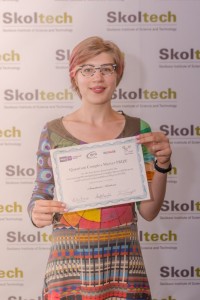Skoltech PhD student Anastasia Aristova has been awarded the best poster prize at Quantum Complex Matter 2018, a prestigious 
international conference hosted by the Rome International Center for Material Science (RICMASS).
It was her research on cuprates – the class of materials exhibiting high-temperature superconductivity – that attracted the jury’s attention. Superconductors can carry an electrical current without dissipation.
“Superconductivity in cuprates was discovered in 1986 – and the next year, the two scientists who discovered it were awarded the Nobel Prize. The reason for this was the fact that cuprates were a qualitatively new class of materials exhibiting the highest transition temperatures among all superconductors known at that time,” said Aristova.
Although the superconducting transition temperature of cuprates can be as high as 164 degrees Kelvin, it falls short of room temperature, which is 290 Kelvin. Over the past 30 years, laboratories worldwide have been scrambling to identify a material capable of superconducting at room temperature. Such a material could revolutionize global energy use, storage and production – affecting everything from how we charge our mobile phones to how we distribute power to remote villages.
“Understanding the superconductivity mechanism in cuprates would be very helpful in the search for room-temperature superconductors, but despite decades of active studies, the question of why cuprates superconduct remains a mystery. The behavior of electrons in cuprates is very complicated. Together with Skoltech Professor Boris Fine, I am working on developing a microscopic model that can explain the most important properties of these electrons,” said Aristova.
In particular, Aristova’s project theoretically investigates a microscopic model based on the assumption that superconductivity emerges in the background of a spontaneously formed electronic inhomogeneous structure that shares certain characteristics of a checkerboard.
Asked what she believed set her project apart in the eyes of the jury at Quantum Complex Matter 2018, the young researcher pointed to the originality of the idea behind the project, as well as the fact that the project focuses on novel aspects of the behavior of cuprates.
Aristova and her team are currently working on a research article that will report their findings.
Skoltech PhD student Anastasia Aristova has been awarded the best poster prize at Quantum Complex Matter 2018, a prestigious international conference hosted by the Rome International Center for Material Science (RICMASS).
It was her research on cuprates – the class of materials exhibiting high-temperature superconductivity – that attracted the jury’s attention. Superconductors can carry an electrical current without dissipation.
“Superconductivity in cuprates was discovered in 1986 – and the next year, the two scientists who discovered it were awarded the Nobel Prize. The reason for this was the fact that cuprates were a qualitatively new class of materials exhibiting the highest transition temperatures among all superconductors known at that time,” said Aristova.
Although the superconducting transition temperature of cuprates can be as high as 164 degrees Kelvin, it falls short of room temperature, which is 290 Kelvin. Over the past 30 years, laboratories worldwide have been scrambling to identify a material capable of superconducting at room temperature. Such a material could revolutionize global energy use, storage and production – affecting everything from how we charge our mobile phones to how we distribute power to remote villages.
“Understanding the superconductivity mechanism in cuprates would be very helpful in the search for room-temperature superconductors, but despite decades of active studies, the question of why cuprates superconduct remains a mystery. The behavior of electrons in cuprates is very complicated. Together with Skoltech Professor Boris Fine, I am working on developing a microscopic model that can explain the most important properties of these electrons,” said Aristova.
In particular, Aristova’s project theoretically investigates a microscopic model based on the assumption that superconductivity emerges in the background of a spontaneously formed electronic inhomogeneous structure that shares certain characteristics of a checkerboard.
Asked what she believed set her project apart in the eyes of the jury at Quantum Complex Matter 2018, the young researcher pointed to the originality of the idea behind the project, as well as the fact that the project focuses on novel aspects of the behavior of cuprates.
Aristova and her team are currently working on a research article that will report their findings.